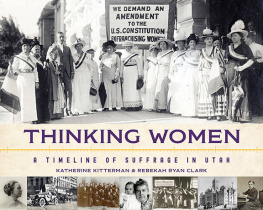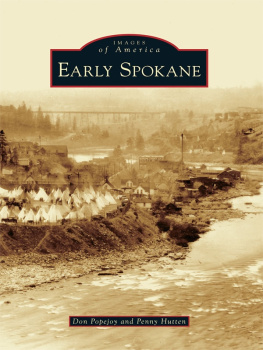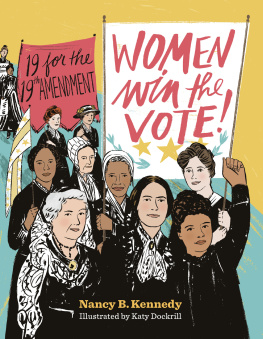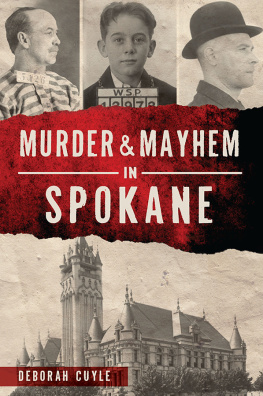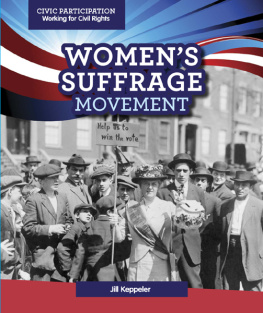
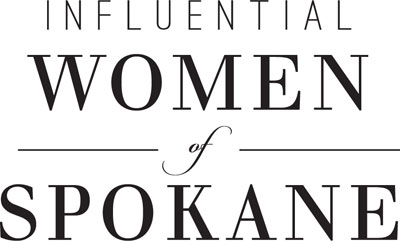

This 1884 map shows the first Catholic church, the Hamblen home and the property Mother Joseph built on. It is the map from which these three details of the property were taken. Courtesy of the Eastern Washington State Historical Society: Museum of Arts and Culture.

Published by The History Press
Charleston, SC
www.historypress.net
Copyright 2017 by Nancy Driscol Engle
All rights reserved
Front cover, clockwise from bottom left: May Arkwright Hutton. Washington State Archives, Eastern Regional Branch, Cheney; Ella Jones. Courtesy of the Eastern Washington State Historical Society, Museum of Arts and Culture, Spokane; Elizabeth Gurley Flynn. Courtesy of the Lawrence History Center, Lawrence, Massachusetts; Alice Ide Houghton. Spokane Falls and Its Exhibition, Matthews Northrup and Co., Buffalo, New York, 1890; Spokane Streets, corner of Sprague and Post. Courtesy of Ned M. Barnes Northwest Room, Spokane Public Library, Spokane.
First published 2017
e-book edition 2017
ISBN 978.1.62585.772.9
Library of Congress Control Number: 2017940932
print edition ISBN 978.1.46711.986.3
Notice: The information in this book is true and complete to the best of our knowledge. It is offered without guarantee on the part of the author or The History Press. The author and The History Press disclaim all liability in connection with the use of this book.
All rights reserved. No part of this book may be reproduced or transmitted in any form whatsoever without prior written permission from the publisher except in the case of brief quotations embodied in critical articles and reviews.
CONTENTS
FOREWORD
INFLUENTIAL WOMEN OF SPOKANE
Visionary and compassionate women profoundly shaped early life in the frontier city of Spokane. Yet they are mostly forgotten. Names like Hutton Settlement, Hamblen Park or Sacred Heart Hospital mark their vibrant contributions, but the paucity of historical records on women leaves us bereft of stories of their lives. What motivated them? How did they demonstrate their concern for the poor, the children, the sick or the women in prison? What public skills, collaborative efforts and strategies did they learn to convince men to give women the right to vote?
Fortunately for Spokane, researcher Nancy Engle brought her formidable skills as a historical detective to write Influential Women of Spokane. Sleuthing for years through every conceivable resource to remember and reimagine their efforts, she also offers insight on the community of women who lived in this booming town at the turn of the nineteenth century. Not only does she include fascinating individual stories, such as the two feisty nuns who came to Spokane in 1886 determined to establish a hospital for the needy, but she also invites readers into the culture of womens clubs, benevolent societies and suffragette organizations that gave a measure of public influence. Here women gathered, grew in leadership, experienced failures and successes, but always with a determination to enhance, even reform the lives of Spokane residents.
Spokanes contemporary slogan, Near Nature, Near Perfect, alludes to what also drew men and women settlers to the historic gem of Spokane Falls, a turbulent city that grew from three thousand to twenty thousand between 1886 and 1890. Spokane Falls served a northwest region with vast timber resources, rich mining discoveries and fertile agricultural lands in the Palouse. The powerful one-hundred-mile Spokane River and four railroads cut through the downtown. The opportunities that abounded attracted both highly educated families from the East and Midwest who wanted education, culture, newspapers and Catholic and Protestant religious values and also a drifting population of men working in forests, mines and farms who found Spokane Falls as their entertainment outlet. By 1886, thirteen churches, six newspapers, six music societies and railroads coexisted with a thriving raw open city serving transient men with saloons, brothels, gambling establishments, Chinese opium dens and shanties. It is in this context that Engle studies the emerging influence of women in meeting the needs of a growing population.
I first became aware of Nancys intense interest in the history of women when she moved from Florida and was researching the Spokane suffragists for her doctorate at the University of Florida. Around the same time, I was researching the life of Helga Estby, a Spokane mother who walked 3,500 miles with her daughter from here to New York City on a $10,000 wager to save their family farm, a remarkable story that had been silenced for almost one hundred years. Later, Helga became involved in our citys suffragist movement, the area of Nancys research, and she generously shared all that she had gathered.
Our shared research fields immersed us in the historical reality of how few resources have been kept on ordinary women who lived extraordinary lives in the late 1800s. Engle demonstrates all the essential qualities needed for historians of lost womens lives. She brings creative delving into limited archival resources and a holistic approach in combining oral histories, photographic and social resources. From these pieces she creates a lively and informative narrative of the women who shaped Spokane.
On our doctoral committees, we both benefited from the guidance of Susan Armitage, a historian then at Washington State University who edited The Womens West, which grew out of the New Western History conference in Wyoming. They called for scholars to research and write stories of ordinary women who lived extraordinary lives. Engles book clearly does this.
In the depth of her portraits of Washington women engaged in the suffrage effort, she addresses the complexities of collaboration that emerged between women over divisions of class, education, religious differences, even proper dress and language, often personified in May Arkwright Huttons flamboyant style. Clear tensions between western Washington and eastern Washington women led to times of explosive conflicts, humiliations, legislative maneuvering and arguments over strategies. Yet they rose above these struggles and never deterred from the ultimate vision of women receiving the right to vote in 1910.
Our city today is renowned in eastern Washington State for the quality and scope of medical care and hospitals; the commitment to education shown through state, parochial, Protestant and city colleges; and resources for children in need. As Engle shows, its no accident. Yet, Spokane still struggles with how to best create opportunities and services for citizens. With over 16 percent living in poverty, too many citizens still face inadequate health and education programs, and adversarial conflicts continue over the city, county and states limited resources.
Engle has provided us with our historical legacy, showing that the origin of boldness, vision, passion, practical efforts and determination of strong women became the backbone of todays city. Their spirit of collaboration, acute awareness of needs, willingness to work together on common goals, staying motivated after failure and caring for the common good has the potential to inspire us. This concise collection of
Next page

